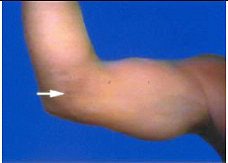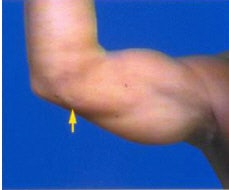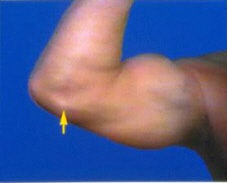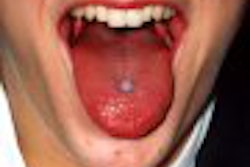
The ancient Greeks enjoyed competitive weightlifting, perhaps for the display of sheer physical strength. But did they also suffer ulnar nerve dysesthesia? The historical record isn’t clear. And neither is the connection between spontaneous numbness in the elbow and a sport that, according to its advocates, is much misunderstood.
"Our sport gets blamed for injuries that have no relation to weightlifting," said Dr. Michael Reed, chairman of sports medicine for USA Weightlifting, the national governing body for Olympic weightlifting in the U.S.
"If you do a medical literature search, you’ll find a lot of injuries that people claim are related to weightlifting, that are in turn miscategorized as weightlifting injuries," Reed said.
One such debatable injury may be caused by hypertrophy of the triceps, when the triceps brachii muscle becomes so enlarged that it grows over the medial side of the elbow, causing severe pain in the elbow, as well as snapping and paresthesias in the ulnar nerve distribution of the hand.
Dr. Robert J. Spinner, associate professor in the departments of neurologic surgery, orthopedics, and anatomy at the Mayo Clinic in Rochester, MN, is certain of the connection between snapping triceps and weightlifting, and in some patients, ulnar nerve paresthesias.
He has participated in several studies of weightlifters and prospective professional football players that have found snapping triceps at levels "significantly above the normal population."
"It’s an entity that needs to be recognized," Spinner said. "If you look for things, they’re there."
One report by Spinner and colleagues describes two patients who had ulnar nerve dysesthesias solely after weightlifting. Using MRI, the authors correlated the presence of symptoms with the intermittent, activity-related snapping of the medial triceps (Journal of the Southern Orthopedic Association, Winter 1999, Vol. 8:4, pp. 288-292).
"In both patients, the symptoms disappeared when the medial portion of the triceps migrated medially, but did not dislocate over the medial epicondyle with elbow flexion," the authors wrote. "Thus, a minor change in the configuration of the medial portion of the triceps (such as fluid accumulation) in the same individual at different times can cause intermittent dislocation of the medial triceps."
 |
| Weightlifter with a several-year history of ulnar nerve symptoms and elbow snapping who had undergone previous ulnar nerve transposition before being correctly diagnosed with snapping triceps. Top picture demonstrates previous incision from a failed ulnar nerve transposition surgery (white arrow). Images courtesy of Dr. Robert Spinner and the Journal of Neurosurgery. |
 |
| Middle image shows triceps posterior to the medial epicondyle (yellow arrow). |
 |
| Bottom picture demonstrates the triceps dislocated anterior to the medial epicondyle where the elbow has been flexed beyond 110 degrees (yellow arrow). |
Once a physician is familiar with the condition, a simple physical exam may allow for diagnosis. But most doctors, Spinner said, would need to see a diagnostic image -- with the elbow in flexion.
"Unless you see the elbow in flexion you will not see the injury," Spinner noted. "An ultrasound has the advantage of being dynamic. You can look at the elbow in real time, in both extension and flexion."
Meanwhile, Reed contends that his sport has "almost nothing to do with the ulnar nerve." In a soon-to-be-published study of about 2,000 competitive weightlifters between the ages of 6 and 16, Reed said that only eight suffered "minor" injuries, and all were able to continue training.
Still, Spinner said, "It’s a rare condition, but one that is often misdiagnosed. It could be that people who have success in weightlifting don’t have it."
The difference between the powerlifting and weight training done in gyms and Olympic weightlifting may also help explain the difference in opinions regarding injuries.
Powerlifting includes many of the usual gym exercises, such as the bench press, squat, and dead lift. In contrast, Olympic weightlifting has just two categories in which participants rely on speed and fluid movement for their power.
In the snatch competition, the lifter uses lesser weights, and raises the bar overhead from the platform in one fluid motion. In the clean and jerk competition, the lifter first "cleans" the weight by securing it at his or her chest (Athens is the second Olympics to feature women's weightlifting), then jerks it overhead. Lifters must hold the weight until the referee issues a "down" signal, which comes only once a lifter is motionless.
Some international events award medals to the best performers in each lifting category, but in the Olympics only one gold medal is awarded per weight class, based on the highest combined total in each category.
Whatever the injury rate, Olympic weightlifting is hard on the body.
Participants are susceptible to injuries in the shoulder and lower back, as well as patellar tendinitis. The medical staff for USA Weightlifting travels with portable digital x-ray devices, which are used most often for spinal examinations and fracture diagnoses.
One particularly gruesome and too-common sight in competitive lifting is that of an athlete losing control of the bar at chest level, driving elbows into thighs, and dropping a massive compressive load into the wrists. When that happens, the debate about hypertrophy of the triceps muscles is left for another day.
By Matt King
AuntMinnie.com contributing writer
August 19, 2004
Related Reading
Ultrasound could help pitchers stay in the game, April 21, 2003
The pitfalls of MR imaging of the elbow -- and strategies for avoiding them, August 14, 2000
Copyright © 2004 AuntMinnie.com



















